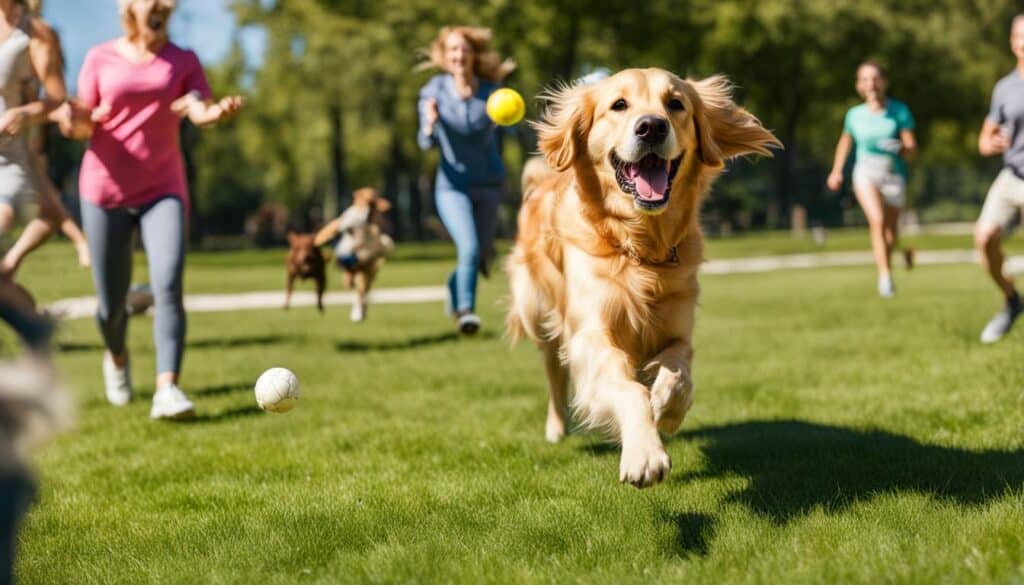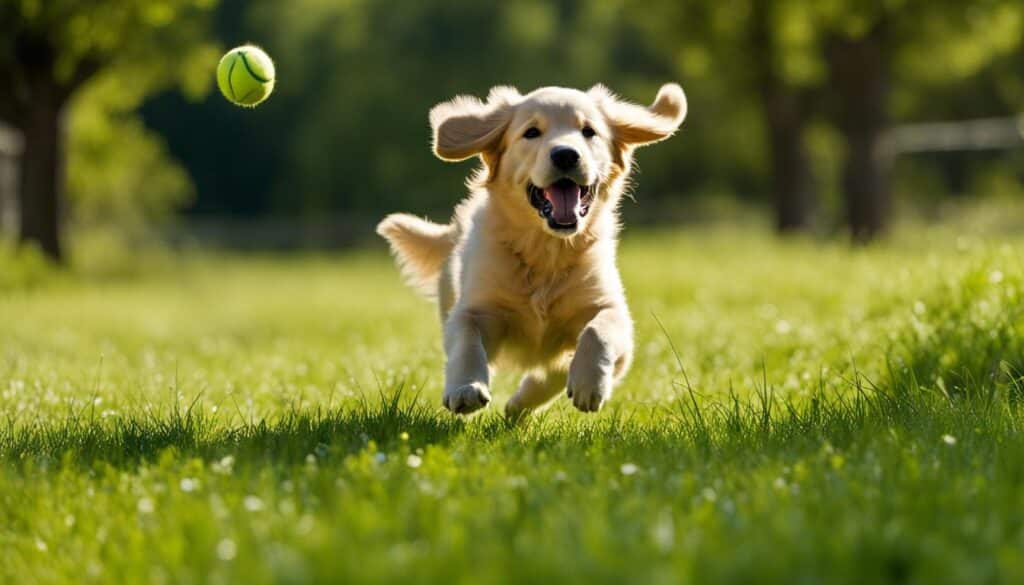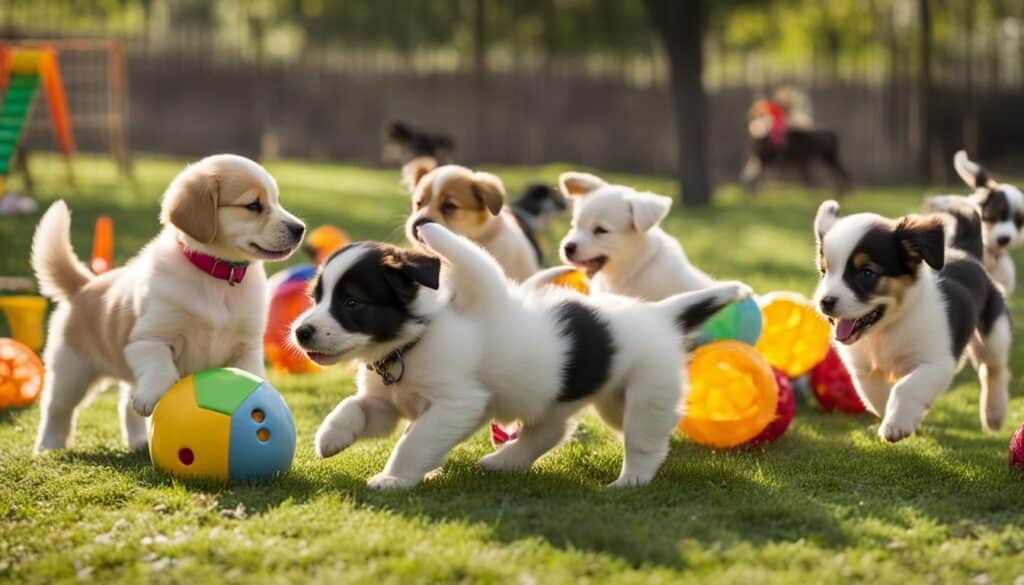Teaching your dog to fetch is more than just fun. It boosts their health and happiness. In this article, we’ll cover the perks of fetch. We’ll show you how it betters their physical and mental state. Plus, we’ll explain how it makes your bond stronger. You’ll get simple steps on training your puppy to fetch reliably. We’ll tackle typical training troubles, too. And we’ll dive into advanced tips, how to keep skills sharp, and fun ways to fetch. Please stick with us to turn fetch into a fantastic experience for your furry friend.

Key Takeaways:
- Fetching is vital for your dog’s physical and mental well-being.
- It provides mental stimulation and boosts focus and brain power.
- It deepens your connection, building trust and better communication.
- Picking a suitable toy and a positive atmosphere is vital for training success.
Why Teach Your Dog to Fetch?
Teaching your dog to fetch is not just for fun. It has many benefits for you and your pet. Fetch keeps your dog’s mind and body healthy. It also makes them happier. So, why is fetch good for your dog? Let’s look at the reasons.
The Benefits of Fetch for Your Retriever
Fetch helps your dog stay fit and healthy. It’s good for their heart and muscles. Running and bringing back toys are great exercises.
Fetch also makes your dog smarter. It teaches them to think fast and solve problems. This keeps their mind sharp and active, making them more intelligent pets.
How Fetch Enhances Your Dog’s Physical and Mental Health
Fetch can fix behavior problems caused by boredom. It gives your dog something fun to do. This stops them from doing bad things around the house.
Fetch also makes your dog happier. It brings joy and reduces stress. Playing fetch can make your dog calmer and more content.
Fetch: More Than Just a Game – A Bonding Experience
Fetch is excellent for bonding with your dog. It helps you understand each other better. Playing together strengthens your connection and trust.
Spending time playing fetch is special. It shows your dog you love them. This builds a solid and loving relationship. Your dog will link fetch with happiness and your care.
Now you know why fetch is so good. It improves your dog’s health and your bond with them. So, grab a toy and start playing fetch with your dog today!
Getting Started: Essentials You Need to Teach Your Dog to Fetch
Before teaching your dog to fetch, you need a few essential things. These steps lay the groundwork for successful training.
Choosing the Right Dummy or Toy for Effective Training
Choosing a safe and suitable dummy or toy is critical. It should match your dog’s size and breed and be durable. Toys made for fetching are great. They are convenient for dogs to grip and bring back.
Consider the toy’s material. Some dogs like softer toys, while others prefer something more complex. Picking a suitable toy makes training fun and keeps your dog interested.
Setting Up a Positive Training Environment for Your Dog
A positive environment is vital for your dog’s learning. Pick a quiet spot without distractions. Make sure to remove any hazards or distracting items.
Use treats, praise, and play for motivation. Reward your dog for successful fetches. A happy training space encourages your dog to learn and enjoy fetch.
Understanding Your Dog’s Drive and Motivation
Every dog is different in what motivates them. Some are driven by food, others by toys. Watch your dog’s behavior to see what works with them.
Tailor your training to fit your dog’s interests. This way, you can make the most of their learning potential. Understanding what drives your dog aids in developing a training plan that works.

Step-by-Step Guide to Train Your Dog to Retrieve Reliably
To train your dog to fetch well, it’s vital to use a detailed guide. This ensures they learn and do the behavior well. We’ll show you how to start fetching, get your dog to hold and return the toy, and slowly up the task challenge.
Introducing the Concept of Fetch to Your Dog
First, show your dog what fetch means. Pick a spot they know and feel calm in for the first lessons. Get them excited about a fetch toy they like. This could be a toy they love or a retriever dummy. Show them the toy as a prize. Use treats and happy words to make them like the toy more.
Encouraging Your Dog to Grab the Toy and Bring It Back
Then, help your dog learn to grab the toy and return it to you. Place the toy gently in their mouth and praise them when they keep it. Call their name and say “fetch” to get them to come back. Give them lots of treats and praise when they return the toy. Keep doing this, slowly moving farther away.

Gradually Increasing the Distance and Adding Challenges
When your dog gets fetch and brings back the toy well, start to throw it farther. Throw the toy a bit away and cheer them on to get it. As they get better, throw the toy farther. Change up where and how you throw to make it fun and tricky.
Try adding things like hurdles or have someone walk past as they fetch. This teaches them to focus and fetch even with distractions around. Always give them a reward when they fetch well. This helps them learn good behavior.
By sticking to this guide, you can teach your dog to fetch well. Being consistent, patient, and using good rewards are essential. With time and work, your dog will get great at fetching. This will make you both happy.
| Step | Action |
| 1 | Introduce the concept of fetch and use positive reinforcement to create a positive association with the toy. |
| 2 | Encourage your dog to grab the toy and bring it back, rewarding them generously when they do. |
| 3 | Gradually increase the distance of the throws and add challenges such as obstacles or distractions. |
Advanced Retrieve Training Techniques for Your Retriever
You can move to the next level after your dog knows the basic retrieve training. This part talks about using training methods made for gun dogs. These are great for retrievers.
We’ll also look at teaching your dog to fetch in different places. This prepares them for situations they’ll meet in real life. Bringing in game birds and scent trails makes training even more exciting. These steps will significantly improve your dog’s fetching abilities.
Incorporating Gun Dog Training Methods for Retrievers
Gundogs, especially retrievers, undergo rigorous training for real-life hunting scenarios. Here’s how to apply these techniques to enhance your retriever’s skills:
- Marking: Teach your dog to watch the fall of object and remember its location. Start practicing by throwing a brightly colored object at short distances.
- Blind Retrieves: Guide your dog to an unseen object using directional commands like “back” (straight out) and “over” (left or right). This develops trust and precise response to your handling.
- Steadiness: Train your dog to remain still even with the excitement of a thrown object. This is crucial for real-world hunting situations.
- Water Retrieves: Introduce water gradually and focus on controlled entries and exits. Practice in shallow areas and provide positive reinforcement after a successful water retrieval.
Training Your Dog to Retrieve in Diverse Environments
- Don’t limit fetch to the park! Diverse environments add challenge and refine your dog’s skills.
- Terrain: Practice on grass, sand, or rough fields. This teaches your dog adaptability and sure-footedness.
- Distractions: Introduce distractions like other dogs, people, or noises. This develops focus even in exciting situations.
- Varying distances and heights: Throw objects farther or up on platforms to add challenge and improve marking skills.
Using Game Birds and Scent Trails to Enhance Training
Scent work and the thrill of the actual game take your retriever’s training to another level:
- Cold Scent Trails: Lay scent trails using game bird wings or training scents. This teaches your dog to follow odor, not just visual cues.
- Live Birds: Under the guidance of an experienced trainer, introduce live game birds. This significantly increases drive and excitement in hunting-focused retrievers.
- Simulated Hunting Scenarios: Participate in training that recreates hunting situations with planted birds, multiple retrieves, and distractions. This prepares your retriever for the complexity of a real hunt.
Important Considerations
- Breed: Certain retrievers have stronger inherent hunting instincts (e.g., Labradors), while others might need extra motivation.
- Safety: Always train in safe, controlled environments. Use caution when working with live birds.
- Positive Reinforcement: Focus on positive reinforcement throughout your training. Punishment hinders progress and can damage your bond with your dog.
Disclaimer: While these techniques provide significant challenges for your dog, it’s important to consult experienced trainers if you’re interested in live bird work or complex hunting scenarios.
Common Problems and Solutions in Retrieve Training
Training your dog to fetch can sometimes be challenging. In this part, we’ll talk about issues you might face and how to solve them.
What to Do If Your Dog Loses Interest in the Game of Fetch
Sometimes, dogs get bored of fetch. Let’s look at ways to make it fun again. You could try these ideas:
- Try out new toys or things to fetch. Changing up the toy can bring back the excitement.
- Play in different places. A new scene can make fetch more enjoyable for your dog.
- Give treats or praise for bringing back the toy. This reward can make them want to play more.
- Include other dogs or people in the game. Your dog might enjoy fetching more with friends around.
How to Correct Inconsistent Retrieving Behavior
Consistent retrieving can be a challenge. But there are ways to fix it:
- Go over the basics of fetch again. Ensure your dog gets it and reward them for getting it right.
- Start with short throws and gradually go farther as they get better.
- If your dog gets distracted, a long line can help keep them focused.
- Lessen distractions at first. Then, slowly add them once your dog gets the hang of fetch.
Adjusting Your Training Approach for Older Dogs and Puppies
Older dogs and puppies need special training tricks:
- Be patient and keep at it. Older dogs and little pups may need more time to learn.
- Think about their health. For older dogs, pick simple activities that don’t hurt. For pups, keep it short and sweet.
- Create the right spot to learn. A quiet place helps puppies focus. Older dogs like a comfy, known spot.
Knowing these tips for fetch training can help you and your dog have better training times.
Maintaining Retrieving Skills and Keeping Fetch Fun
Once your dog learns how to fetch, keeping up their abilities and making fetch fun is key. Adding fetch to everyday workouts provides mental and body exercise for your dog.
Integrating Fetch into Daily Exercise Routines
Make fetch part of your dog’s daily workout to keep them busy and fit. Head to the park or a big area where they can run and chase toys. This keeps their fetch skills sharp and ensures they get enough exercise to remain healthy.
Varying Toys and Scenarios to Keep Training Engaging
Changing up the toys and how you play fetch keeps your dog interested and eager. Try different toys like balls, discs, or ropes. Switch up where you throw the toy, like behind or hiding a tree, to improve their fetch skills and thinking.
Participating in Dog Sports and Competitions to Showcase Skills
Joining dog sports and contests is a great way to show off your dog’s fetch skills. It lets them show what they can do and compete with other dogs. Trying out agility, flyball, or obedience trials gives your dog a fun challenge.
Using these ideas, you can keep your dog’s fetch skills sharp, make fetch exciting, and let them shine in dog sports and contests.
Conclusion
Teaching your dog to fetch is gratifying. It improves their health and their bond. Follow the steps, address issues, and practice to see benefits.
Fetch does more than entertain. It keeps your dog fit and your relationship strong. So grab a toy and start this fun training journey.

